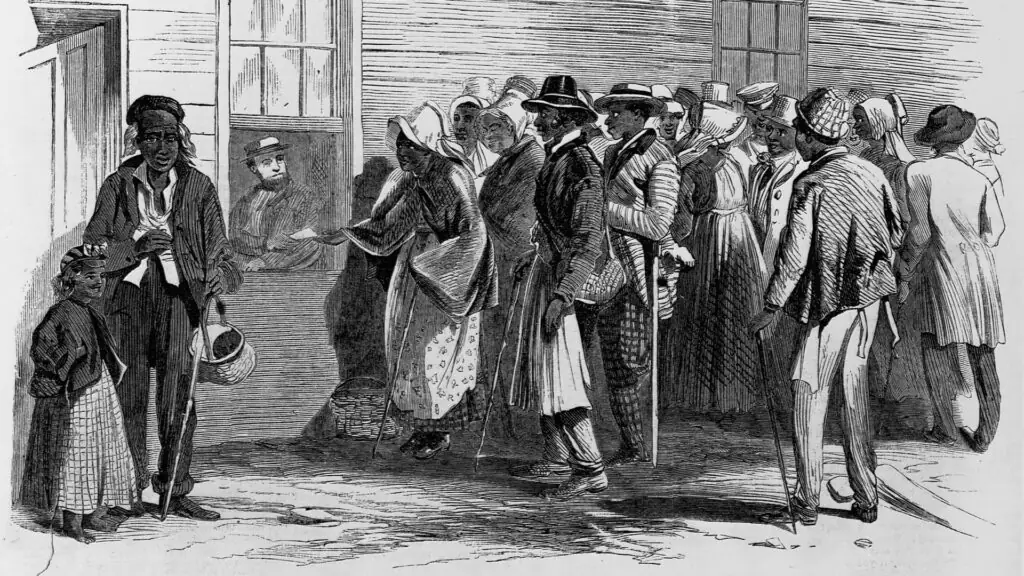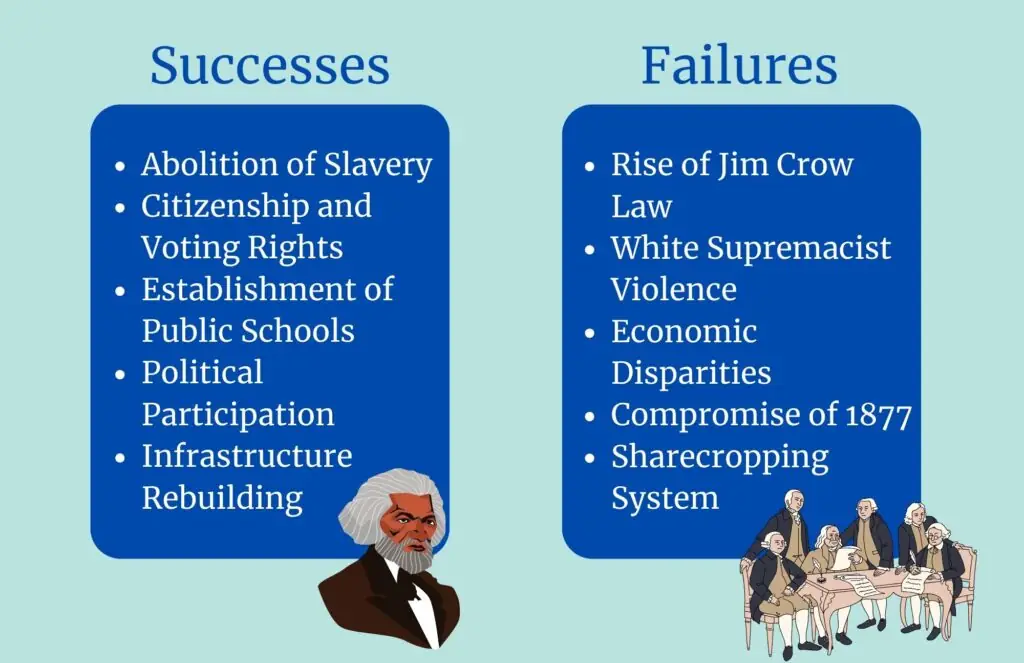The Reconstruction era was a period in American history that followed the end of the Civil War. This era, lasting from 1865 to 1877, had the goal to rebuild the Southern states that had seceded and to integrate formerly enslaved African Americans into society as equal citizens.

✅ AI Essay Writer ✅ AI Detector ✅ Plagchecker ✅ Paraphraser
✅ Summarizer ✅ Citation Generator
However, despite its noble intentions, Reconstruction did not achieve its goals. Political opposition from Southern Democrats, economic struggles, and social resistance against the rights of African Americans contributed to the overall failure of Reconstruction. The withdrawal of federal troops from the South marked the end of Reconstruction, leading to the rise of white supremacist groups and the implementation of Jim Crow laws that enforced racial segregation.
The failure of Reconstruction had long-lasting effects on the United States, particularly in the South, where African Americans faced a century of segregation and disenfranchisement. Let’s look at the issues behind Reconstruction point by point.
The Goals of Reconstruction After the Civil War
Immediately after the Civil War, the United States was in a state of devastation and division. The South, in particular, faced economic ruin, with its infrastructure destroyed and its social and political systems in disarray. The war had also left the nation with the problem of integrating millions of freed slaves into society as free citizens with equal rights.
The initial objectives of Reconstruction were designed to address these issues and rebuild the nation.
- Reintegrating the Southern states that had seceded back into the United States.
- Making sure that African Americans had the rights and opportunities to participate fully in society.
Restorating the Union required delicate political work. The federal government needed to re-establish governance in the Southern states while also holding them accountable for their rebellion. This process involved endless debates over the conditions for readmission to the Union and the extent of federal oversight necessary to make sure people will remain loyal.
The integration of freed slaves was an even more of a challenge. The end of slavery left millions of African Americans seeking their place in a society that had long oppressed them. Reconstruction aimed to provide legal protections for these individuals, granting them rights such as citizenship, the right to vote, and access to education. However, these efforts were met with resistance, and the struggle for civil rights would continue long after the end of Reconstruction.
The Reasons Why Reconstruction Failed
One of the major problems was the resistance from Southern Democrats, who were opposed to the changes being implemented. They wanted to preserve their traditional way of life, which included white supremacy. The compromise of 1877, where Rutherford B. Hayes was elected as President in exchange for the withdrawal of federal troops from the South, marked the end of Reconstruction. Without the presence of federal troops, the Southern states were free to revert to their old ways, messing up all of the progress that had been made.

The South’s economy was in ruins after the Civil War. The destruction of infrastructure and the abolition of slavery, which had been the foundation of the Southern economy, left the region struggling. The policies implemented during Reconstruction were unable to address these problems.
There was significant societal pushback against the rights of African Americans. The rise of white supremacist groups, such as the Ku Klux Klan, aimed to intimidate and oppress African Americans and their allies. The implementation of Jim Crow laws legalized racial segregation and disenfranchised African Americans, further solidifying white dominance in the South. This social resistance made it difficult for African Americans to exercise their newfound rights and for the goals of Reconstruction to be fully realized.
Lasting Effects of Reconstruction’s Failure
As a result, Reconstruction had significant and long-lasting consequences, particularly for African Americans and the Southern states.

The collapse of Reconstruction marked the beginning of a horrible period for African Americans. The end of federal intervention in the South allowed for the implementation of Jim Crow laws, which were mentioned above. African Americans were systematically disenfranchised, stripped of their voting rights, and subjected to widespread violence and oppression. This era of segregation and disenfranchisement lasted for nearly a century, limiting the opportunities and rights of African Americans because some white people were offended at the thought of equality.
This failure also had long-lasting economic and social effects on the Southern states. The region’s economy struggled to recover from the Civil War, and the lack of effective policies during Reconstruction meant that the South remained economically disadvantaged compared to the rest of the country. Socially, the failure forced even more racial divisions and animosity, and shaped the region’s attitudes and policies for generations to come.
Let’s look at the consequences (positive and negative) with a bit more detailing.
| Successes | Failures |
|---|---|
| The 13th Amendment officially abolished slavery in the United States. | After the end of Reconstruction, Southern states implemented Jim Crow laws, enforcing racial segregation and discrimination. |
| The 14th and 15th Amendments granted citizenship to all born in the U.S. and voting rights to African American men. | Groups like the Ku Klux Klan used violence and intimidation to suppress African American political participation. |
| Reconstruction led to the establishment of public schools in the South, improving access to education. | The South’s economy remained largely agricultural and underdeveloped compared to the North, with many African Americans trapped in a cycle of poverty. |
| African Americans held public office at local, state, and national levels during Reconstruction. | The withdrawal of federal troops from the South marked the end of Reconstruction, leading to the erosion of African American rights. |
| Reconstruction efforts led to improvements in the South’s infrastructure, including roads, bridges, and railroads. | Many freed slaves became sharecroppers, a system that often resulted in debt and economic exploitation. |
What Did We Learn?
Political opposition from Southern Democrats, economic struggles in the post-war South, and social resistance against the rights of African Americans all negatively influenced efforts to rebuild and integrate the nation. The compromise of 1877, which led to the withdrawal of federal troops from the South, marked the end of Reconstruction and allowed the reinstatement of white supremacy.
FAQ
Follow us on Reddit for more insights and updates.





Comments (0)
Welcome to A*Help comments!
We’re all about debate and discussion at A*Help.
We value the diverse opinions of users, so you may find points of view that you don’t agree with. And that’s cool. However, there are certain things we’re not OK with: attempts to manipulate our data in any way, for example, or the posting of discriminative, offensive, hateful, or disparaging material.